Get Involved!
Are you a homeowner, business owner, faith community leader, or other individual looking to get involved in Chesapeake Bay cleanup? If so, you are one of MDE's non-government partners and a vital part of our Bay cleanup efforts.
Learn More
Excess Nutrients Have Polluted the Chesapeake
Humans are Responsible
Humans have severely disrupted the natural balance of nutrients entering the Chesapeake Bay. Since the industrial revolution, a population boom in the Bay’s watershed has caused a sharp rise in nutrient pollution (leaving MDE). This dramatic increase in nutrients flowing into the Bay has overburdened the Chesapeake's waters.
Point Source vs Nonpoint Source Pollution
Pollution falls into one of two categories depending on how it enters the environment: point source, or nonpoint source. These two broad classifications help define the impacts of pollution and challenges associated with pollution reduction and control.
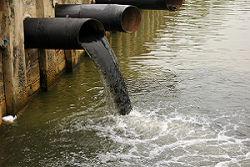 Like its name suggests, point source pollution comes from a single, easily identifiable point, such as a pipe.
Like its name suggests, point source pollution comes from a single, easily identifiable point, such as a pipe.
-
Point Source Pollution originates from a single, easily identifiable source, and is the form of pollution with which most people are familiar.
-
Where Does it Come From?
Point source pollution can come from anywhere, but it is typically most closely associated with urbanized areas. Factories, fossil fuel power plants, cars, and wastewater treatment plants are all types of point sources.
-
What Environmental Impacts Does it Have?
Point source pollution is more concentrated than nonpoint source pollution. However, because it comes from a single source, or “pipe,” it is also easier to control. For this reason, point source pollution tends to be the most cost-effective pollution to control and typically yields the largest immediate reductions.
-
Why is it a Problem?
If left unchecked, point source pollution is considerably more concentrated than nonpoint source pollution and can have a devastating impact on the environment.
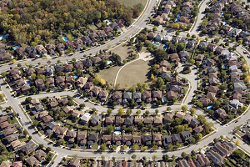 Lawns and roadways are common examples of nonpoint source pollution.
Lawns and roadways are common examples of nonpoint source pollution.
-
Nonpoint Source Pollution comes from a broad area where it is not possible to readily identify a single source of contamination.
-
Where Does it Come From?
Nonpoint source pollution is widespread and comes from urban, suburban, and rural areas. Parking lots, roadways, rooftops, lawns, and farms are all types of nonpoint sources.
-
What Environmental Impacts Does it Have?
Unlike point source pollution, nonpoint source pollution is typically found in lower levels and has a low to moderate immediate environmental impact.
-
Why is it a Problem?
Nonpoint pollution is challenging and costly to control. While the pollution sources are diffuse, the full amount of nonpoint source pollution that drains into the Chesapeake is significant and rivals that of point sources.
What are Nutrients and Sediments?
Nitrogen and phosphorus are collectively referred to as "nutrients" when discussing nutrient pollution in the Chesapeake. These two chemicals are primary building blocks of life and are the basis of most plant fertilizers.
Sediments are small particles of dust, dirt, and other fine materials. These particles get washed into rivers, transport other pollutants, and cloud the water.
Learn more about the types of nutrient pollution (leaving MDE)
Origins of Nutrient Pollution in the Bay
Where do Nutrients Come From?
When living things die, they are broken down into their basic chemical components through a process known as decomposition. Specialized microbes transform these basic compounds into usable nutrients for plants and algae. The plants and algae feed on these nutrients and move them through the food web. These nutrients can come from many different sources, including natural, agricultural, and urban sources which are collectively known as source sectors.
Nutrient Source Sectors:
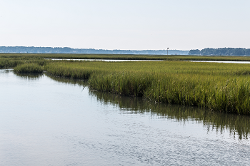 Natural sources of nutrients are necessary to the health of the Bay.
Natural sources of nutrients are necessary to the health of the Bay.
Natural Sources of nutrients produce a small fraction of the total nutrient load delivered to the Chesapeake. Natural sources are not considered pollution and provide the nutrients that are essential to life in the Bay.
Sources include:
- Forests
- Meadows
- Wetlands
- Other natural ecosystems
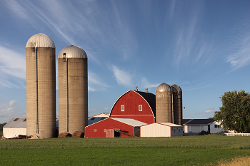 Nutrients washed off of fields can have significant impacts on water quality.
Nutrients washed off of fields can have significant impacts on water quality.
Agricultural Sources of nutrients produce about half of the total excess nutrients flowing into the Chesapeake (leaving MDE). Agriculture contributes primarily nonpoint source pollution and has a less severe immediate environmental impact. While no one farm adds much pollution to the Bay, the cumulative amount of diffuse pollution has significant impacts on water quality.
Sources include:
- Animal Waste
- Crop Production
- Nurseries
- Pasture
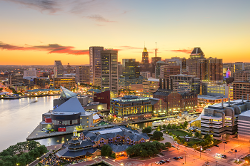 Cities, suburbs, and other urban settings contribute to nutrient pollution.
Cities, suburbs, and other urban settings contribute to nutrient pollution.
Urban Sources of nutrients produce approximately the other half of excess nutrients delivered to the Chesapeake. Urban sources are a mix of point source (leaving MDE) and nonpoint source pollution (leaving MDE) and have a moderate to high environmental impact. Urban nonpoint source pollution is highly diffuse and among the most costly and challenging pollution to control.
Sources include:
- Land Development
- Septic Systems
- Stormwater Runoff
- Wastewater Treatment Plants
How do Nutrients Get Into the Bay?
-
Air
While there is naturally occurring nitrogen in the atmosphere, the burning of fossil fuels releases additional nitrogen compounds into the air (leaving MDE). By a process known as atmospheric deposition, some of this nitrogen is absorbed by the water and some of it falls over the land. The nitrogen compounds that settle on land are picked up by rainwater and washed into streams.
-
Land
When water falls onto the land, it flows over the surface until it is either absorbed into the ground or reaches a stream (leaving MDE). This runoff picks up nutrients and other contaminants and washes them into streams or absorbs them into the groundwater. Due to human activity, there is an increased presence of nutrients and other pollutants on the ground that comes from cities, suburban areas, and farms. These nutrients wash into the Bay, contaminate the water, and can cause ecological harm.
-
Water
Nutrients that are washed into rivers, or leached into the groundwater, eventually make their way to the main stem of the Chesapeake Bay. Rivers and streams rapidly transport nutrients to the Bay (leaving MDE), but also respond quickly to nutrient cleanup. On the other hand, groundwater moves slowly and acts as a reservoir that can deliver excess nutrients to the Bay long after the source of pollution has abated (leaving MDE). This reservoir of nutrients in the groundwater creates lag time between nutrient reductions on land and measurable results in the water.
Nutrient and Sediment Pollution Harms the Bay
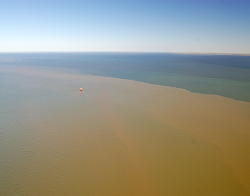 Sediment carries pollution and blocks light from aquatic plants.
Sediment carries pollution and blocks light from aquatic plants.
Image courtesy of Alexandra Fries - IAN/EcoCheck.
Sediments Cloud the Water
During storms, surface runoff washes sediments from lawns, fields, and roadways into the Chesapeake Bay and its tributaries. Sediments transport other pollutants and cloud the water (leaving MDE), turning it a murky brown.
Continually muddy water degrades water quality and presents a serious problem for organisms living beneath the surface. Like land plants, water plants and other aquatic photosynthetic organisms rely on sunlight to survive. Prolonged lack of sunlight can harm aquatic plants and ultimately result in their death if the water does not clear. When these plants die, they no longer act as buffers to hold sediments to the bottom. This creates conditions where bottom sediments are more easily disturbed, further clouding the water.
 Excess nutrients fuels harmful algal blooms that turn the water a murky green.
Excess nutrients fuels harmful algal blooms that turn the water a murky green.
Image courtesy of Giancarlo Cichetti - USEPA.
Excess Nitrogen and Phosphorus Harm the Bay
While some nitrogen and phosphorus are essential to life in the Bay, an overabundance of these nutrients can devastate plants and aquatic wildlife. Excess nutrients in the water disrupt the energy flow in the Bay and can cause ecosystem collapse through a process known as eutrophication.
What is Eutrophication?
Eutrophication (pronounced You-tro-fih-cay-shun) is the natural aging process by which lakes and other water bodies slowly turn into swamps and bogs. Humans have grossly accelerated this natural process by over fertilizing algae in the Chesapeake, causing devastating effects on the ecosystem and wildlife. These effects are common in the warm summer months when conditions for rapid algae growth are favorable.
Under normal circumstances, a combination of limited resources and predators keep algae populations under control. However, excess nutrients in the water disrupt this delicate balancing act by providing the algae with virtually unlimited resources. Like over fertilizing weeds in a garden, this causes an explosion of algae growth, known as an algae bloom. Algal blooms can overwhelm the ecosystem, choke out other life, and create a nuisance to humans.
What do We have to Lose?
There is an incredible diversity of plants and animals in the Chesapeake. They filter the water, create a vast web of life, support the local economy, and make the Chesapeake Bay a National Treasure.
Learn More
-
How Does Eutrophication Harm Plants?
Algae blooms can completely block sunlight from beneath the surface. Without sunlight, aquatic plants along the bottom will die. Algal blooms are especially harmful when combined with muddied waters caused by excess sediments entering the Bay.
-
How Does Eutrophication Harm Animals?
When the algae bloom dies, it sinks to the bottom and triggers an explosion of bacterial population growth and activity. While decomposing the algae, the bacteria use oxygen for respiration. This respiration required for decomposition depletes the water of oxygen, causing a condition known as hypoxia (oxygen-poor) (leaving MDE). In severe cases of eutrophication, bacteria can completely deplete the water of oxygen, resulting in a condition known as anoxia (zero oxygen).
Like their air-breathing counterparts, fish, and other water-breathing organisms require oxygen to survive (leaving MDE). The low oxygen levels caused by eutrophication can physically stress animals, while anoxic levels can kill them. These areas of anoxic water, frequently known as “dead zones,” are places where few organisms can survive and are the leading cause of fish kills (leaving MDE) in the Chesapeake.
-
A Runaway Cycle
Human-caused eutrophication is an example of what is known as a positive feedback loop or a “runaway” cycle. When living things die, they release nutrients into the water and provide additional fuel to the cycle. As more nutrients enter the water, more algae bloom, and as more algae bloom, more algae die, providing more food to the bacteria that further deplete the water of oxygen. This cycle can last for months, destroy habitat, and has crippling impacts on wildlife.
BMPs are Cleaning the Chesapeake
Maryland's Bay Cleanup Plan makes use of a wide variety of BMPs to reduce nutrients entering the Chesapeake Bay. These BMPs form the foundation of Bay nutrient reduction and represent concrete actions taken to restore the Bay.
Learn More
There are Ways to Reduce Pollution
Best Management Practices
Best Management Practices (BMPs) are a collection of actions, policies, and physical structures that are used to reduce nutrient pollution. Different categories of BMPs can be used to fight excess nutrients in a variety of ways.
Diversity in BMPs Provides Comprehensive Cleanup Solutions
For Bay restoration, there is no "one size fits all" BMP solution. The Chesapeake Bay is an incredibly complex ecosystem; equally complex are local budgets and other domestic needs that elected officials must carefully consider. Effective nutrient management strategies make use of the full portfolio of available BMPs to balance local budgetary restrictions with environmental restoration needs.
Types of Best Management Practices
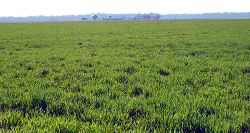 Cover crops are an annual BMP and must be replanted every year.
Cover crops are an annual BMP and must be replanted every year.
Image courtesy of Caroline Wicks - IAN, UMCES.
Annual BMPs are actions or practices performed on a yearly basis. An advantage of annual BMPs is that they are easy and relatively inexpensive to implement. However, because annual BMPs require an annual action or installation, they tend to be less efficient and more costly in the long run than structural BMPs.
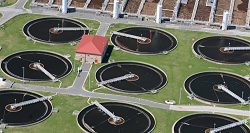 Structural BMPs can be costly, yet highly effective pollution reduction methods.
Structural BMPs can be costly, yet highly effective pollution reduction methods.
Image courtesy of Jane Thomas - IAN, UMCES.
Structural BMPs are physical BMPs that are installed to prevent pollution. Unlike annual BMPs, they have the advantage of being “one and done." However, structural BMPs tend to be more costly than annual BMPs, making it not always feasible to perform widespread implementation.
-
Examples of Structural BMPs Include:
Wastewater Treatment Plant upgrades, septic system BAT upgrades, stormwater retrofits, rain gardens, and tree planting.
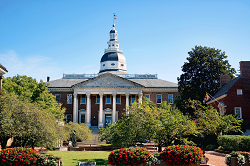 Policy BMPs can be powerful drivers of Bay cleanup measures.
Policy BMPs can be powerful drivers of Bay cleanup measures.
Policy BMPs are a series of laws and regulations that can act as a powerful tool in reducing nutrient pollution. Policy BMPs can require the use of other categories of BMPs to achieve the desired nutrient reductions. Additionally, they can restrict or prohibit certain practices or actions. However, political and regulatory tensions and obstacles can limit the use of policy BMPs.
-
Examples of Policy BMPs Include:
Impervious surface regulation, fertilizer laws, septic system BAT upgrades, and required reforestation.
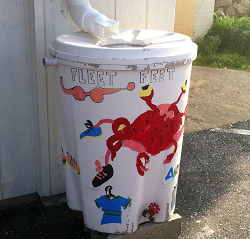 Installing a rain barrel to reduce runoff is an example of a voluntary practice BMP.
Installing a rain barrel to reduce runoff is an example of a voluntary practice BMP.
Image courtesy of Caroline Wicks - IAN, UMCES.
Voluntary Actions and Practices are performed on an individual basis and can include both annual and structural BMPs. Voluntary measures and practices have the advantage of being highly flexible and a source of local involvement in Bay restoration. However, they cannot be considered a reliable method of reducing pollution because individuals can choose not to participate.
-
Examples of Voluntary Actions and Practice BMPs Include:
Cleaning up pet waste, keeping lawn trimmings out of stormwater drains, planting rain gardens, community litter cleanup, and other personal actions that benefit the Bay.
Up Next: Bay Restoration as a Coordinated Effort
Chesapeake Bay restoration has been a continual series of steps with each improving upon the last. Ensuring these measures produce results requires close cooperation with other Bay jurisdictions.
Learn more about how Maryland partners with federal, state, and local governments.
Contact Information